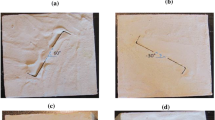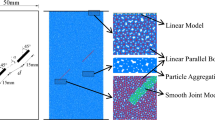Abstract
To investigate the influence of infilled flaws on mechanical properties and failure modes of rock masses, seven types of pre-existing infilled two-flaw specimens, which have different flaw inclination angle (α), rock bridge length (L2) and rock bridge inclination angle (β), were made from concrete. The crack coalescence process, failure modes and mechanical parameters of the specimens under triaxial or biaxial compression were studied by lab test and numerical tests, respectively. According to test results, two failure modes of specimen (shear failure, tensile–shear failure) and three rock bridge coalescence modes (tensile crack coalescence, shear crack coalescence, no coalescence) were identified. As the rock bridge length and inclination angle increase, the peak strengths of specimens also increase gradually, while the peak strengths of specimens decrease with flaw inclination angle being increase. The shear strength parameters (cohesion c and internal friction angle φ) of samples show nonlinear changes with various factors (flaw angle, rock bridge length, rock bridge angle). The particle flow code (PFC) was used to simulate the propagation process of microcracks and porosities, stress–strain curves for loading process were also obtained, numerical results are in good agreement with experimental results. The number of cracks and porosities increase rapidly in the post-peak stage, and a significant shear fracture zone was caused by cracks. This study provides a better understanding of peak strength and cracking behaviour of rock mass containing infilled flaws.

















Similar content being viewed by others
References
Moghadami M, Mortazavi A (2018) Development of a risk-based methodology for rock slope analysis. Int J Civ Eng 16(10):1317–1328
Huang X, Liu QS, Liu B, Liu XW, Pan YC, Liu JP (2017) Experimental study on the dilatancy and fracturing behavior of soft rock under unloading conditions. Int J Civ Eng 15(6):921–948
Tokiwa T, Tsusaka K, Aoyagi K (2018) Fracture characterization and rock mass damage induced by different excavation methods in the Horonobe URL of Japan. Int J Civ Eng 16(4):371–381
Gratchev I, Kim DH, Yeung CK (2016) Strength of rock-like specimens with pre-existing cracks of different length and width. Rock Mech Rock Eng 49(11):4491–4496
Haeri H, Shahriar K, Marji MF, Moarefvand P (2014) Cracks coalescence mechanism and cracks propagation paths in rock-like specimens containing pre-existing random cracks under compression. J Cent South Univ 21(6):2404–2414
Abdollahipour A, Fatehi MM (2017) Analyses of inclined cracks neighboring two iso-path cracks in rock-like specimens under compression. Geotech Geol Eng 35(1):169–181
Fan X, Li KH, Lai HP, Xie YL, Cao RH, Zheng J (2018) Internal stress distribution and cracking around flaws and openings of rock block under uniaxial compression: a particle mechanics approach. Comput Geotech 102:28–38
Fan X, Li KH, Lai HP, Zhao QH, Sun ZH (2018) Experimental and numerical study of the failure behavior of intermittent rock joints subjected to direct shear load. Adv Civ Eng 2018:1–19
Sun SR, Sun HY, Wang YJ, Wei JH, Liu J, Kanungo DP (2014) Effect of the combination characteristics of rock structural plane on the stability of a rock-mass slope. Bull Eng Geol Environ 73(4):987–995
Cao RH, Cao P, Lin H, Pu CZ, Ou K (2016) Mechanical behavior of brittle rock-like specimens with pre-existing fissures under uniaxial loading: experimental studies and particle mechanics approach. Rock Mech Rock Eng 49(3):763–783
Zhao YL, Zhang LY, Wang WJ, Pu CZ, Wan W, Tang JZ (2016) Cracking and stress–strain behavior of rock-like material containing two flaws under uniaxial compression. Rock Mech Rock Eng 49(7):2665–2687
Cao P, Liu TY, Pu CZ, Lin H (2015) Crack propagation and coalescence of brittle rock-like specimens with pre-existing cracks in compression. Eng Geol 187:113–121
Wang M, Cao P, Wan W, Zhao YL, Liu J, Liu JS (2017) Crack growth analysis for rock-like materials with ordered multiple pre-cracks under bi axial compression. J Cent South Univ 24(4):866–874
Huang YH, Yang SQ, Tian WL, Zeng W, Yu LY (2016) An experimental study on fracture mechanical behavior of rock-like materials containing two unparallel fissures under uniaxial compression. Acta Mech Sin 32(3):442–455
Feng P, Dai F, Liu Y, Xu NW, Du HB (2019) Coupled effects of static-dynamic strain rates on the mechanical and fracturing behaviors of rock-like specimens containing two unparallel fissures. Eng Fract Mech 207:237–253
Wang M, Cao P (2017) Experimental study of crack growth in rock-like materials containing multiple parallel pre-existing flaws under biaxial compression. Geotech Geol Eng 35(3):1023–1034
Xiao TL, Huang M, Cheng C, He YL (2018) Experimental investigation on the mechanical characteristics and deformation behavior of fractured rock-like material with one single fissure under the conventional triaxial compression. Shock Vib 2018:1–11
Mirzaghorbanali A, Nemcik J, Aziz N (2014) Effects of cyclic loading on the shear behavior of infilled rock joints under constant normal stiffness conditions. Rock Mech Rock Eng 47(4):1373–1391
Liu RC, Jing HW, He LX, Zhu TT, Yu LY, Su HJ (2017) An experimental study of the effect of fillings on hydraulic properties of single fractures. Environ Earth Sci 76(20):684
Shrivastava AK, Rao KS (2018) Physical modeling of shear behavior of infilled rock joints under CNL and CNS boundary conditions. Rock Mech Rock Eng 51(1):101–118
Jahanian H, Sadaghiani MH (2015) Experimental study on the shear strength of sandy clay infilled regular rough rock joints. Rock Mech Rock Eng 48(3):907–922
Ma H, Liu QS (2017) Prediction of the peak shear strength of sandstone and mudstone joints infilled with high water-cement ratio grouts. Rock Mech Rock Eng 50(8):2021–2037
Sagong M, Bobet A (2002) Coalescence of multiple flaws in a rock-model material in uniaxial compression. Int J Rock Mech Min 39(2):229–241
Yu J, Chen X, Cai YY, Li H (2016) Triaxial test research on mechanical properties and permeability of sandstone with a single joint filled with gypsum. KSCE J Civ Eng 20(6):2243–2252
Papaliangas T, Hencher SR, Lumsden AC, Manolopoulou S (1993) The effect of frictional fill thickness on the shear strength of rock discontinuities. Int J Rock Mech Min Sci Geomech Abstr 30(2):81–91
Saeb S, Amadei B (1992) Modelling rock joints under shear and normal loading. Int J Rock Mech Min Sci Geomech Abstr 29(3):267–278
Indraratna B, Welideniya HS, Brown ET (2005) A shear strength model for idealised infilled joints under constant normal stiffness. Geotechnique 55(3):215–226
Liu J, Wang J (2018) Stress evolution of rock-like specimens containing a single fracture under uniaxial loading: a numerical study based on particle flow code. Geotech Geol Eng 36(1):567–580
Li G, Liang ZZ, Tang CA (2015) Morphologic interpretation of rock failure mechanisms under uniaxial compression based on 3D multiscale high-resolution numerical modeling. Rock Mech Rock Eng 48(6):2235–2262
Tang CA, Lin P, Wong RHC, Chau KT (2001) Analysis of crack coalescence in rock-like materials containing three flaws—Part II: numerical approach. Int J Rock Mech Min 38(7):925–939
Wong RHC, Tang CA, Chau KT, Lin P (2002) Splitting failure in brittle rocks containing pre-existing flaws under uniaxial compression. Eng Fract Mech 69(17):1853–1871
Liu HY, Zhang YD (2018) Numerical simulation of the failure process and mechanical behavior of a rock material with nonpersistent cracks under compression. Arab J Sci Eng 43(7):3673–3683
Cheng H, Zhou XP, Zhu J, Qian QH (2016) The Effects of crack openings on crack initiation, propagation and coalescence behavior in rock-like materials under uniaxial compression. Rock Mech Rock Eng 49(9):3481–3494
Chong Z, Li X, Yao Q, Zhang J, Chen T (2016) Anchorage behavior of reinforced specimens containing a single fissure under uniaxial loading: a particle mechanics approach. Arab J Geosci 9(12):592
Yin Q, Jing H, Su H (2018) Investigation on mechanical behavior and crack coalescence of sandstone specimens containing fissure-hole combined flaws under uniaxial compression. Geosci J 22(5):825–842
Le HL, Sun SR, Kulatilake P, Wei JH (2018) Effect of grout on mechanical properties and cracking behavior of rock-like specimens containing a single flaw under uniaxial compression. Int J Geomech 18(10):04018129
Wong RHC, Chau KT (1998) Crack coalescence in a rock-like material containing two cracks. Int J Rock Mech Min 35(2):147–164
ASTM (2004) Standard test method for triaxial compressive strength of undrained rock core specimens without pore pressure measurements (Withdrawn 2005), ASTM D2664-04. ASTM, West Conshohocken, PA
Lajtai EZ (1974) Brittle fracture in compression. Int J Fract 10(4):525–536
Bobet A (2000) The initiation of secondary cracks in compression. Eng Fract Mech 66(2):187–219
Yang SQ, Jing HW (2011) Strength failure and crack coalescence behavior of brittle sandstone samples containing a single fissure under uniaxial compression. Int J Fract 168(2):227–250
Park CH, Bobet A (2009) Crack coalescence in specimens with open and closed flaws: a comparison. Int J Rock Mech Min 46(5):819–829
Wong LNY, Einstein HH (2009) Systematic evaluation of cracking behavior in specimens containing single flaws under uniaxial compression. Int J Rock Mech Min 46(2):239–249
Sun HY (2015) Research on fracture mechanism of non-penetrative jointed rock mass based on random structure plane. Master thesis, Hohai University, Nanjing (in Chinese)
Le HL, Sun SR, Wei JH (2019) Influence of types of grouting materials on compressive strength and crack behavior of rocklike specimens with single grout-infilled flaw under axial loads. J Mater Civ Eng 31(1):06018022
Zhuang XY, Chun JW, Zhu HH (2014) A comparative study on unfilled and filled crack propagation for rock-like brittle material. Theor Appl Fract Mech 72(1):110–120
Cho N, Martin CD, Sego DC (2007) A clumped particle model for rock. Int J Rock Mech Min 44(7):997–1010
Potyondy DO, Cundall PA (2004) A bonded-particle model for rock. Int J Rock Mech Min 41(8):1329–1364
Acknowledgements
This study is financially supported by the Natural Science Foundation of China (nos. 41672258, 41102162). The authors would also like to acknowledge the editors and reviewers of this paper for their very helpful comments and valuable remarks.
Author information
Authors and Affiliations
Corresponding author
Rights and permissions
About this article
Cite this article
Wang, W., Sun, S., Le, H. et al. Experimental and Numerical Study on Failure Modes and Shear Strength Parameters of Rock-Like Specimens Containing Two Infilled Flaws. Int J Civ Eng 17, 1895–1908 (2019). https://doi.org/10.1007/s40999-019-00449-8
Received:
Revised:
Accepted:
Published:
Issue Date:
DOI: https://doi.org/10.1007/s40999-019-00449-8




